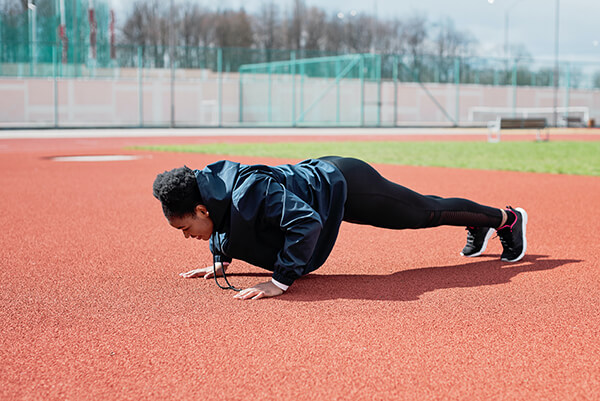How much exercise do I need?
We are often told that “exercise is good for you” and to “make sure you are getting enough exercise.” But what exactly does this mean? What constitutes as “exercise” and how much exercise is “enough?” Before we dive into specific exercise recommendations, it is helpful to first understand the various factors that play a role in determining how much exercise we should be striving for. When it comes to exercise, there are several factors to consider including: type, intensity, time and frequency.

Type
Type of exercise refers to the kind of exercise you are doing. The two main types of exercise are aerobic and anaerobic. Aerobic exercise is more commonly referred to as cardiovascular exercise, or “cardio,” and includes a variety of activities such as walking, hiking, running, cycling, swimming, rowing, skiing and more. Anaerobic exercise is better known as strength training and includes activities such as weightlifting, body building, Olympic lifting and powerlifting. Aerobic and anaerobic training can also be combined, as commonly seen with CrossFit® and Orange Theory Fitness®. When it comes to choosing a specific type of aerobic, anaerobic or combined exercise program, there is no one superior mode. It all comes down to what is recommended for your age, health status and personal preference. If, for example, you are a healthy individual with no contraindications to running, but find running to be boring, there is no rule stating that you must run just because it will improve your cardiovascular endurance. There are plenty of other activities, as noted above, that will do the same thing and allow you to have fun at the same time.
Intensity
Intensity refers to how difficult the exercise feels and the amount of energy expended while exercising. Intensity of physical activity is further broken down into four different categories: light-intensity, moderate-intensity, moderate-to-vigorous intensity, and vigorous intensity. To determine what level of intensity you are exercising at, a scale known as the “rate of perceived exertion” (also known as RPE) is used. The RPE scale is a scale from zero to 10, where zero is considered “no effort” and 10 is considered “maximal effort.” Using this scale: light-intensity = 2-4, moderate-intensity = 5-6, moderate-to-vigorous intensity = 5-8, and vigorous intensity = 7-8. When you exercise, think about how you feel during the activity and try rating it using the RPE scale. Keep in mind that this scale is completely subjective, meaning that it is based on an individual’s personal capacity, and therefore will vary from person to person. For example, two different people can go for a five-mile bike ride at the same speed, along the same exact route, and for the same exact duration of time, but one person may rate it as a “5” and another might rate it at a “2.” This is completely normal and okay, as our individual health and fitness status varies.
Time
Time refers to the amount of time spent exercising during a single session, usually measured in minutes.
Frequency
Frequency refers to how often an individual exercises and is typically measured as the number of days per week.
Now that the variables related to exercise prescription have been broken down, you can use this information to help guide you in understanding the recommended activity guidelines. So, the question remains—how much exercise should you be getting? Per the World Health Organization and the Centers for Disease Control and Prevention, the summarized recommendations are as follows:
Children and adolescents (five–17 years old)
At least 60 minutes of physical activity per day throughout the week of moderate-to-vigorous intensity, with at least three days per week of vigorous intensity (i.e., soccer) and moderate-to-vigorous anaerobic exercise (i.e., push-ups).
Adults (18-64 years old, including those with chronic conditions and disability)
150 to 300 minutes per week of moderate-to-vigorous intensity aerobic exercise (i.e., brisk walking), 75 to 150 minutes per week vigorous intensity aerobic exercise (i.e., running), or a combination of moderate and vigorous intensity. At least two days per week of moderate or higher intensity anaerobic exercise (i.e., weightlifting).
Older adults (65 years and older, including those with chronic conditions and disability)
At least 150 minutes per week of moderate-intensity aerobic exercise (i.e., brisk walking), at least three days per week of moderate-to-vigorous intensity anaerobic exercise (i.e., weightlifting), and activities to improve balance (i.e., single leg balance).
Pregnant and postpartum women
At least 150 minutes per week moderate-intensity aerobic exercise (i.e., brisk walking).
For healthy individuals, consultation with a health care professional prior to beginning an exercise program is not required. For individuals with chronic health conditions, disability, pregnancy and postpartum, consultation with a health care provider may be required. Examples of health conditions that may require consultation include, but are not limited to, the following: hypertension, cardiovascular disease, type 1 diabetes mellitus, type 2 diabetes mellitus, chronic obstructive pulmonary disease, and cancer.
For all individuals beginning an exercise program, it is recommended to consult with a health care provider if any new symptoms develop. Such symptoms include, but are not limited to, the following: dizziness, lightheadedness, fainting, nausea, confusion, headache and chest pain.
Not sure if you should check with your doctor first? When in doubt, always check with a health care professional before beginning a new exercise program, to discuss the benefits and risks of exercise, and to determine the appropriate type and level of activity based on your individual abilities and needs.
Erika is a physical therapist with Dee PT, where her area of focus is general orthopedics.
